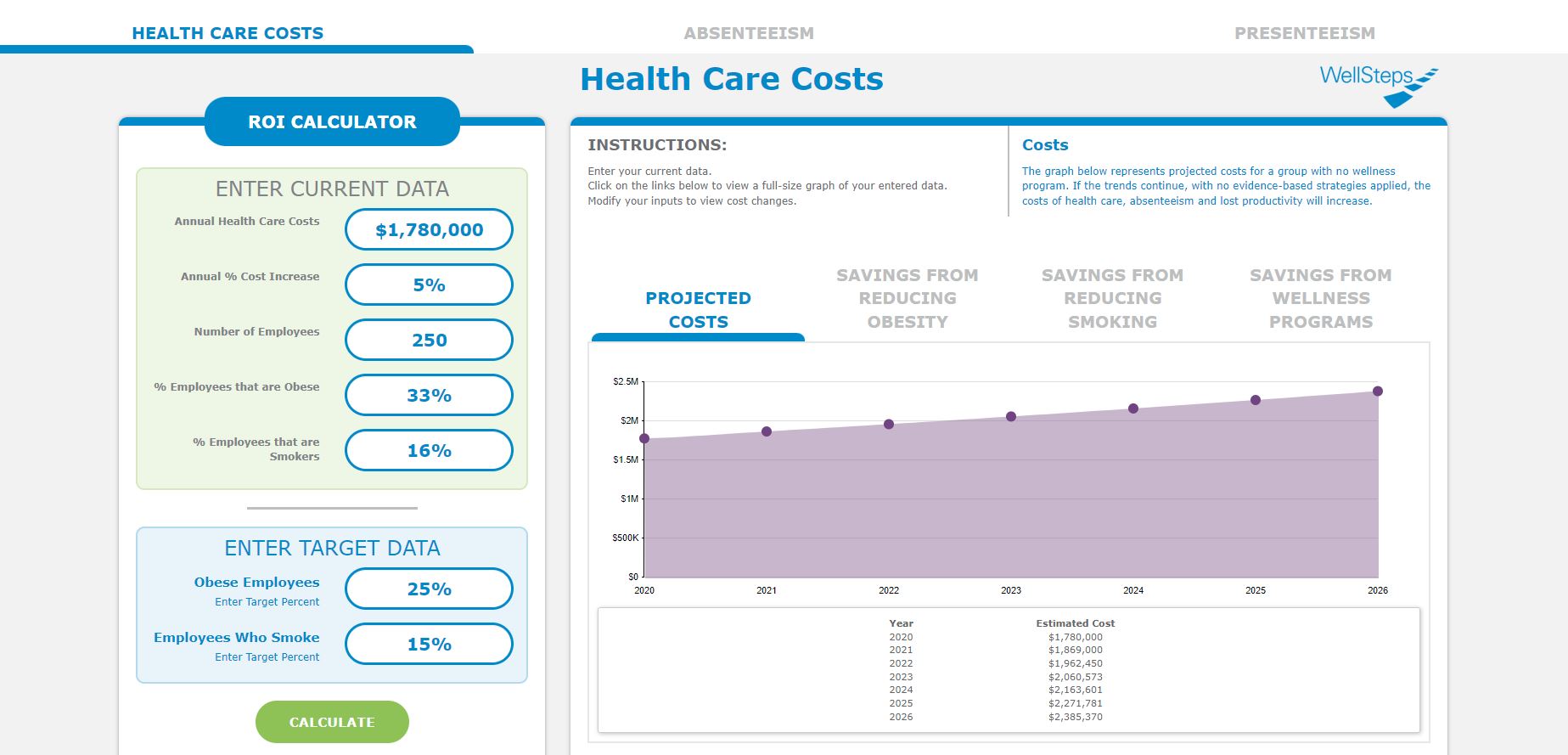These days there is a lot of talk about the wellness ROI (return on investment) vs VOI (value on investment) of employee well-being programs. Some have suggested that wellness ROI is no longer important and that all wellness outcomes should be measured in terms of value (or wellness VOI). This article will review why that is definitely not the case.

What is Wellness ROI?
To understand what wellness ROI really is, we have to consider all of the reasons that companies do employee well-being programs in the first place. Most of the time, a wellness program is implemented with the hopes of controlling healthcare costs, improving employee health, or improving employee productivity.
The table below is a fairly exhaustive list of the known reasons for doing worksite wellness. They range from saving healthcare dollars to just plain having fun. Ninety-one percent of employers report offering health and well-being programs for reasons beyond medical cost savings.
| Reasons for Doing A Well-being Program | Type of Data | Measure Used |
|---|---|---|
| Manage or reduce health care costs Reduce the number of sick days Manage/reduce disability claims |
Most companies have medical claims, absenteeism and disability data. These are easier to evaluate because data is more readily available. These are financial measures reported in dollars. |
ROI |
| Reduce employee health risks Improve employee job satisfaction Improve employee productivity Improve employee morale Attract or retain talented employees Improve employee energy levels at work Increase on-the-job safety Impact business performance and profitability . Improve comradery and team effectiveness Reduce presenteeism Have fun |
These outcomes are more difficult, if not impossible to accurately measure. Special efforts and expense are required to get these data. They are considered “softer” measures because they are often self-reported. They are not reported in dollars. |
VOI |
The Goals of an Employee Well-Being Program
The best employee well-being programs have goals that include reducing healthcare costs, absenteeism, and disability. These benefits can be quantified by summing the dollars saved by the wellness program divided by the dollars spent on the wellness program. This is the classic wellness ROI analysis, sometimes known as a benefit-to-cost ratio.

For example, if a well-being program has a wellness ROI of 3.1, that means that it saved $3.1 for every dollar that was spent offering the program. An ROI of 1 means the program broke even. There have been several scientific publications that have evaluated the wellness ROI of health promotion programs. Typically, they look at healthcare costs saved divided by the cost of the program.
These are very large and complex actuarial studies that carefully compare healthcare expenditures of wellness program participants and non-participants across time.
How do you calculate ROI for wellness programs?
If you already have a wellness program in place, or if you are debating whether it will be worth it to start one, click here to use the free WellSteps ROI calculator. Numerous scientific studies back it, and researchers update it each year with the most recent findings.

Do Wellness Programs Really Save Companies Money?
If the WellSteps ROI calculator has not convinced you that, dollar for dollar, employee wellness programs can save your company money, here is a flat out number for you: a 2019 report by the International Foundation of Employee Benefit Plans found that most employers in North America saved between $1 and $3 in health care costs for every $1 spent on company wellness programs.
We are so confident about the cost effectiveness of employee wellness programs that WellSteps offers a performance guarantee. We guarantee in year one that over 50% of eligible employees will participate, in year two that employees will demonstrate a significant improvement in health behaviors, and in year three we guarantee a positive wellness ROI.
In reality, by the time our clients reach year three, they no longer care about the wellness ROI. They and their employees deeply value the new culture that an effective wellness program has created. In other words, the wellness value on investment becomes the most significant indicator of success.
What is Wellness VOI?
Just like ROI, a wellness VOI analysis also tries to compare employee well-being program participants to non-participants, but in addition to looking at dollars saved, they also look at other measures such as job satisfaction or employee morale.
Value on investment is not a very easy term to understand because it’s not very descriptive. Wellness VOI measures often rely on self-reported data, require additional data collection and expenses, and people consider them “softer” metrics.
It’s clear that the best worksite well-being programs impact employee morale, but how exactly can employee morale be quantified? The same applies to team cohesiveness, recruitment, or retention.
But, these are all questions related to wellness value on investment. A wellness VOI evaluation does not produce a numeric ratio like a wellness ROI does. The results of a wellness VOI study just state the facts: the program improved job satisfaction by X amount.
How Should Wellness VOI Be Used?
Some individuals believe they must choose only a single measurement technique – they advocate for either wellness ROI or wellness VOI, but not both. However, this perspective is flawed. While quantifying “softer measures” may pose challenges, top-notch worksite wellness programs have the potential to influence a broad spectrum of outcomes within an organization.
These outcomes may include tangible metrics like healthcare cost claims, as well as qualitative measures such as reductions in accidents per month, improvements in blood glucose levels, or enhancements in self-reported job satisfaction scores.
The Metrics
Disregarding financial outcomes in favor of solely focusing on other metrics is like relying solely on blood tests to gauge changes in blood glucose levels while disregarding feedback from self-reported assessments of mental well-being or dietary analyses. Each assessment provides valuable insights; they simply gauge different aspects. Wellness Value on Investment (VOI) is essentially a term indicating a desire to assess how a wellness program impacts the qualitative aspects within an organization.

The truth is that the data used in wellness ROI analyses tends to be pretty reliable and somewhat easy to obtain. After all, companies pay healthcare costs as expenses. In short, we can track spending and identify where the money went. By digging into the claims data, splitting it between participants and non-participants, and extending the study over several years, we can clearly see the healthcare cost trends linked to the wellness program.
However, companies don’t normally gather employee morale data. They rarely gather information on productivity, energy levels, or presenteeism – the data on wellness VOI. Because, these types of data require special surveys and an extraordinary effort on the part of the company to collect and evaluate.
Since most companies don’t have this type of data readily available, they don’t perform the research. Researchers publish lots of wellness ROI studies because, in most worksites, the data needed for wellness ROI studies already exists.
Outside of the U.S., the wellness VOI is about the only reason companies do wellness. Around the world, the need to control employee-related healthcare costs is nonexistent.
In these countries, companies use worksite wellness programs solely to boost productivity and add value from the workforce. There is little need to conduct wellness ROI analyses when wellness VOI is the primary reason programs exist.
The Goals of the Best Employee Well-being Programs
Another compelling reason for the widespread interest in wellness VOI is evident. With each passing year, the number of companies implementing wellness programs continues to rise. Nowadays, the majority of employees have access to such programs through their employers.
However, not all of these initiatives prove effective; indeed, some may even do more harm than good. Nevertheless, the overall caliber of wellness programs has never been better.
Interestingly, many employers with a successful employee well-being program no longer prioritize wellness ROI. Initially, the inception of such programs was likely driven by a desire to reduce healthcare expenditures. However, as these programs matured, their value to the organization became increasingly apparent.
When a company implements a well-being program effectively, employees experience a positive shift in their well-being as they actively engage in cultivating healthier lifestyles. This leads to heightened employee morale and job satisfaction, consequently enhancing the overall mood and culture of the organization.
What initially began as a strategic approach to managing employee-related expenses (with a focus on wellness ROI) transforms into a cultural shift within the organization. In fact, this shift fosters an environment that encourages employees to lead healthier lives, aligning with a wellness VOI focus.
So, the pursuit of a high wellness ROI turns into a realization that there is tremendous value in having healthy, happy employees. These employer groups gradually discover that there is true value in having a healthy, vibrant, and productive workforce. In short, it turns out that the wellness VOI of well-being programs ends up being the most important outcome of an effective well-being program.

The reality is that both ROI and VOI are measures of value. Both are measures of financial value. ROI is a cost/benefit measure, while VOI is a cost/effectiveness measure. (See the PHA/HERO Program Measurement and Evaluation Guide: Core Metrics for Employee Health Management, page 67).
I would agree that we need to demonstrate worksite wellness program value in the broadest sense, not just financial value. The good news is that most, if not all the reasons for doing a wellness program can be measured accurately. Many scientifically validated survey instruments are available for the practitioner to utilize.
ROI and VOI are both the result of outcome type evaluation strategies. It is important for worksite wellness practitioners to understand that outcome evaluation strategies are only one type of program evaluation. Process and impact type program evaluations should not be overlooked as ways to demonstrate program value.
Comments are closed.